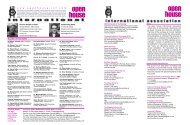Vol :37 Issue No.1 2012 - Open House International
Vol :37 Issue No.1 2012 - Open House International
Vol :37 Issue No.1 2012 - Open House International
Create successful ePaper yourself
Turn your PDF publications into a flip-book with our unique Google optimized e-Paper software.
of the poor in identifying and occupying well-located<br />
land is dismissed as an illegal process rather<br />
than appreciating some of the benefits of the<br />
process, learning from it and supporting it through<br />
expert involvement. Adopting a “first-world<br />
approach” of eradication and “clean-up” is disadvantaging<br />
many communities who are unable to<br />
enter the, many times unaffordable, formal sector.<br />
Most often these informal settlements are<br />
located on the outer periphery of cities and industrial<br />
areas – in this way, the informal dwellers are<br />
near enough to serve the city (they are therefore<br />
close to job opportunities) but they are not close<br />
enough to be served by the facilities available in the<br />
city. South African cities, despite political change<br />
since the end of Apartheid, stubbornly maintain<br />
patterns of segregation. The proliferation of informality<br />
is in many ways attributed to past spatial<br />
injustice, a process that generated some of the<br />
most inequitable cities in the world. Anger against<br />
the state has intensified in many forms. Numerous<br />
social and political problems such as violence,<br />
crime, service delivery protests and xenophobia<br />
might be a result of these spatial inequities. It is<br />
generally agreed that the problems facing these<br />
areas need to be urgently addressed if political stability<br />
is to be achieved.<br />
Existence of an informal area is treated as<br />
temporary by authorities; however, the reality is that<br />
many informal areas continue to be in existence for<br />
long periods of time and are therefore quite well<br />
established. The inhabitants of informal settlements<br />
are generally resourceful and innovative in devising<br />
systems of habitation that are well-located (close to<br />
work opportunities), that are affordable, that can be<br />
constructed speedily and dismantled just as easily.<br />
While upgrading and integrating informal<br />
areas into cities is the accepted approach, it is also<br />
acknowledged that mass-regularisation might also<br />
be problematic where it might prove to be impossible<br />
to formalise at a large scale given the extent of<br />
informality that exists in the country. Many scholars<br />
have called for an incremental approach where<br />
there is no strict distinction between formal and<br />
informal. Some have asked for investigating different<br />
forms of tenure security. There is a call to investigate<br />
the domain between strictly formal and informal,<br />
the “in-between” zone, in terms of physical<br />
structures, finance models and forms of ownership,<br />
that might include group ownership as opposed to<br />
a western system of individual ownership.<br />
Some attempts have been made at an<br />
area-based approach to upgrading as opposed to<br />
focussing on the individual houses. In all cases,<br />
what is important is that addressing informality<br />
needs to be done in an innovative manner that is<br />
unique to context and that benefits the inhabitants.<br />
This is what this project set out to investigate, as well<br />
as to address the negative connotations of informal<br />
settlements.<br />
There is a deeper intrinsic quality to an<br />
informal setting. “Emergence” of informal settlements<br />
within South Africa is both instant and gradual,<br />
determined by the intensity of energy at a particular<br />
time: need, economy, opportunities, politics,<br />
etc. A form of street grid is established, organic by<br />
nature and true to the energy which shaped it. The<br />
scale and layout is often more suited to a pedestrian<br />
scale as it is determined by the main “mode of<br />
transport” within the settlement, walking on foot.<br />
The ubiquitous ‘tin’ shack, reminiscent of<br />
many informal settlements throughout the world is<br />
pragmatic, functional, affordable, but inadequate.<br />
While it functions well as a rain-screening shelter,<br />
the South African method predominantly uses a<br />
timber structure, usually with a recycled steel sheet<br />
clad exterior offering the user only the bare essentials<br />
of a shelter.<br />
Informal settlements are in constant flux.<br />
Even when settlement boundaries have been<br />
defined by existing formal settlements, infrastructure<br />
or natural edges, such as steep slopes or rivers,<br />
within these boundaries, change in built fabric continually<br />
manifests through altering dwelling configurations.<br />
The disassembly and recycling of structures,<br />
together with new informal additions and<br />
extensions to older structures, creates an environment<br />
that is constantly being remodelled as<br />
dwelling units are adapted for increased practicality<br />
and density.<br />
In order to remove demeaning overtones, it<br />
is essential for an architectural intervention not to<br />
be condescending, but rather uplifting and empowering,<br />
initiating a change in the outsiders’ perception<br />
of informal settlements and their inhabitants<br />
while stimulating the self-help strategies of the<br />
inhabitants. Architects have a special role to play in<br />
this process: “New imaginations are needed, both<br />
7 3<br />
open house international <strong>Vol</strong>.<strong>37</strong> <strong>No.1</strong>, March <strong>2012</strong> Environments of change: an <strong>Open</strong> Building approach... Donovan Gottsmann and Amira Osman





